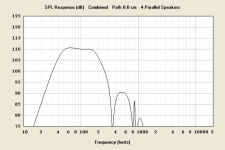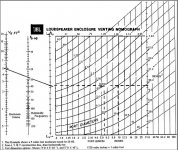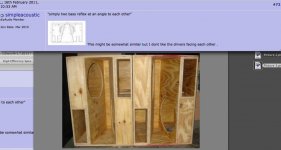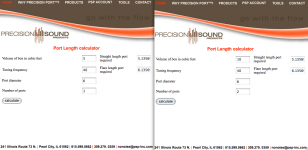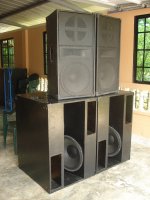Back in the mid 1980's I had a lot of L4 and L2 cabinets ( 24 4 x15", 4 2x15") that were similar to what you came up with here, though my cabinets came to a "V" all the way to the back of the cabinet, both sides had separate chambers. Separate chambers lowers distortion a little.This is where I've reached so far..
View attachment 214881
Sounds awesome (very rich bass) without much eq ,tried it out with a car amp.
So it should be even better with my xover, eq, and power.
Someone said it should be called the cross-eyed monster.
The design originated when we cut the last 15 inches off 4 x15" straight horns, then added ports. The cabinets went from 45 to 30 inches in depth, the 45" depth had been a problem in many venues we were working in.
The hybrid retained the "punch" of the horn, with the LF extension the bass reflex added. More bass using 1/3 less space, yay!
Later, we tried the same cabinet with two 15" instead of four, using cover plates over the two unused holes. The LF output remained almost exactly the same, just less upper bass response.
Still had a bit of a rising upper response compared to a standard BR, but the extra headroom the "horn" provides up higher is helpful in large rooms.
Installing the two speakers "cross eyed" gave more output and sounded better than mounting the speakers both on the top or bottom.
Art
Last edited:
Well,at the beginning of this thread ,my idea was to have the chambers separated {as in the first pencil sketch}.Then with a lot of help of NeoDan who modeled and finalized all the plans for me ,came up with the manifold style i.e having a single chamber.
I am very curious about the difference although I'm very happy so far with the performance
I am very curious about the difference although I'm very happy so far with the performance
Last edited:
Looks good
With separate chambers the ports would have been deeper than the box.
Ahh ,I see.I'm very contented so far anyways.
The volume per speaker and volume of cabinet to port ratio remains the same whether one large box with two speakers or two smaller boxes with a single speaker in each.Looks good
With separate chambers the ports would have been deeper than the box.
Separate chambers would not require any change in the ports, Fb would remain the same either case.
The only difference would be in sound quality, not frequency response or output level.
Those are the charts I still use, I love nomographs."The volume per speaker and volume of cabinet to port ratio remains the same whether one large box with two speakers or two smaller boxes with a single speaker in each."
Don't think so, it's not a linear function. Do you remember porting charts pre-computer era?
It does not matter if you build one big box with two speakers and two ports or two boxes half the size with one port and one speaker each, other than intermodulation distortion is reduced using separate chambers per speaker.
Do the math, you will see.
Art
Attachments
Name: Kappalite 3015LF
Type: Standard one-way driver
Company: Eminence Speaker LLC
No. of Drivers = 2
Mounting = Standard
Wiring = Parallel
Fs = 42 Hz
Qms = 6.82
Vas = 158.8 liters
Cms = 0.144 mm/N
Mms = 99.68 g
Rms = 3.857 kg/s
Xmax = 9.6 mm
Xmech = 14.4 mm
P-Dia = 334.9 mm
Sd = 881 sq.cm
P-Vd = 0.846 liters
Qes = 0.41
Re = 5.31 ohms
Le = 0.92 mH
Z = 8 ohms
BL = 18.46 Tm
Pe = 450 watts
Qts = 0.387
no = 2.767 %
1-W SPL = 96.57 dB
2.83-V SPL = 98.35 dB
-----------------------------------------
Box Properties
Name:
Type: Vented Box
Shape: Prism, square (optimum)
Vb = 8 cu.ft
Fb = 40 Hz
QL = 5.488
F3 = 51.67 Hz
Fill = minimal
No. of Vents = 2
Vent shape = round
Vent ends = one flush
Dv = 8 in
Lv = 12.5 in
---------------------------------------
Name: Kappalite 3015LF
Type: Standard one-way driver
Company: Eminence Speaker LLC
No. of Drivers = 1
Fs = 42 Hz
Qms = 6.82
Vas = 158.8 liters
Cms = 0.144 mm/N
Mms = 99.68 g
Rms = 3.857 kg/s
Xmax = 9.6 mm
Xmech = 14.4 mm
P-Dia = 334.9 mm
Sd = 881 sq.cm
P-Vd = 0.846 liters
Qes = 0.41
Re = 5.31 ohms
Le = 0.92 mH
Z = 8 ohms
BL = 18.46 Tm
Pe = 450 watts
Qts = 0.387
no = 2.767 %
1-W SPL = 96.57 dB
2.83-V SPL = 98.35 dB
-----------------------------------------
Box Properties
Name:
Type: Vented Box
Shape: Prism, square (optimum)
Vb = 4 cu.ft
Fb = 40 Hz
QL = 5.488
F3 = 51.67 Hz
Fill = minimal
No. of Vents = 1
Vent shape = round
Vent ends = one flush
Dv = 8 in
Lv = 14.01 in
---------------------------------------------------------
--------
Driver Properties
Name: Kappalite 3015LF
Type: Standard one-way driver
Company: Eminence Speaker LLC
No. of Drivers = 2
Mounting = Standard
Wiring = Parallel
Fs = 42 Hz
Qms = 6.82
Vas = 158.8 liters
Cms = 0.144 mm/N
Mms = 99.68 g
Rms = 3.857 kg/s
Xmax = 9.6 mm
Xmech = 14.4 mm
P-Dia = 334.9 mm
Sd = 881 sq.cm
P-Vd = 0.846 liters
Qes = 0.41
Re = 5.31 ohms
Le = 0.92 mH
Z = 8 ohms
BL = 18.46 Tm
Pe = 450 watts
Qts = 0.387
no = 2.767 %
1-W SPL = 96.57 dB
2.83-V SPL = 98.35 dB
-----------------------------------------
Box Properties
Name:
Type: Vented Box
Shape: Prism, square (optimum)
Vb = 8 cu.ft
Fb = 40 Hz
QL = 5.488
F3 = 51.67 Hz
Fill = minimal
No. of Vents = 1
Vent shape = round
Vent ends = one flush
Dv = 11.31 in
Lv = 10.7 in
"It does not matter if you build one big box with two speakers and two ports or two boxes half the size with one port and one speaker each"
Hmmm, doesn't look that way from here.
Two drivers and one port or two ports of the same area give different lengths. One driver and one port of the same area of the two driver two port gives another length. The difference between 10.7" and 14.01" is quite a bit.
I used to use the exact same chart you put up, but I found the computer sim was closer in actual use.
Type: Standard one-way driver
Company: Eminence Speaker LLC
No. of Drivers = 2
Mounting = Standard
Wiring = Parallel
Fs = 42 Hz
Qms = 6.82
Vas = 158.8 liters
Cms = 0.144 mm/N
Mms = 99.68 g
Rms = 3.857 kg/s
Xmax = 9.6 mm
Xmech = 14.4 mm
P-Dia = 334.9 mm
Sd = 881 sq.cm
P-Vd = 0.846 liters
Qes = 0.41
Re = 5.31 ohms
Le = 0.92 mH
Z = 8 ohms
BL = 18.46 Tm
Pe = 450 watts
Qts = 0.387
no = 2.767 %
1-W SPL = 96.57 dB
2.83-V SPL = 98.35 dB
-----------------------------------------
Box Properties
Name:
Type: Vented Box
Shape: Prism, square (optimum)
Vb = 8 cu.ft
Fb = 40 Hz
QL = 5.488
F3 = 51.67 Hz
Fill = minimal
No. of Vents = 2
Vent shape = round
Vent ends = one flush
Dv = 8 in
Lv = 12.5 in
---------------------------------------
Name: Kappalite 3015LF
Type: Standard one-way driver
Company: Eminence Speaker LLC
No. of Drivers = 1
Fs = 42 Hz
Qms = 6.82
Vas = 158.8 liters
Cms = 0.144 mm/N
Mms = 99.68 g
Rms = 3.857 kg/s
Xmax = 9.6 mm
Xmech = 14.4 mm
P-Dia = 334.9 mm
Sd = 881 sq.cm
P-Vd = 0.846 liters
Qes = 0.41
Re = 5.31 ohms
Le = 0.92 mH
Z = 8 ohms
BL = 18.46 Tm
Pe = 450 watts
Qts = 0.387
no = 2.767 %
1-W SPL = 96.57 dB
2.83-V SPL = 98.35 dB
-----------------------------------------
Box Properties
Name:
Type: Vented Box
Shape: Prism, square (optimum)
Vb = 4 cu.ft
Fb = 40 Hz
QL = 5.488
F3 = 51.67 Hz
Fill = minimal
No. of Vents = 1
Vent shape = round
Vent ends = one flush
Dv = 8 in
Lv = 14.01 in
---------------------------------------------------------
--------
Driver Properties
Name: Kappalite 3015LF
Type: Standard one-way driver
Company: Eminence Speaker LLC
No. of Drivers = 2
Mounting = Standard
Wiring = Parallel
Fs = 42 Hz
Qms = 6.82
Vas = 158.8 liters
Cms = 0.144 mm/N
Mms = 99.68 g
Rms = 3.857 kg/s
Xmax = 9.6 mm
Xmech = 14.4 mm
P-Dia = 334.9 mm
Sd = 881 sq.cm
P-Vd = 0.846 liters
Qes = 0.41
Re = 5.31 ohms
Le = 0.92 mH
Z = 8 ohms
BL = 18.46 Tm
Pe = 450 watts
Qts = 0.387
no = 2.767 %
1-W SPL = 96.57 dB
2.83-V SPL = 98.35 dB
-----------------------------------------
Box Properties
Name:
Type: Vented Box
Shape: Prism, square (optimum)
Vb = 8 cu.ft
Fb = 40 Hz
QL = 5.488
F3 = 51.67 Hz
Fill = minimal
No. of Vents = 1
Vent shape = round
Vent ends = one flush
Dv = 11.31 in
Lv = 10.7 in
"It does not matter if you build one big box with two speakers and two ports or two boxes half the size with one port and one speaker each"
Hmmm, doesn't look that way from here.
Two drivers and one port or two ports of the same area give different lengths. One driver and one port of the same area of the two driver two port gives another length. The difference between 10.7" and 14.01" is quite a bit.
I used to use the exact same chart you put up, but I found the computer sim was closer in actual use.
Last edited:
That's usually the trap that inexperienced simulator users fall into.
I expect better from someone who uses charts.
A double volume box with double the driver count does not require double the identical ports to achieve the same tuning.
Look up any standard formula for port tuning and you will see that DJK is correct.
I expect better from someone who uses charts.
A double volume box with double the driver count does not require double the identical ports to achieve the same tuning.
Look up any standard formula for port tuning and you will see that DJK is correct.
any one else reading this should be aware that Welter is quoting complete nonsense.The volume per speaker and volume of cabinet to port ratio remains the same whether one large box with two speakers or two smaller boxes with a single speaker in each.
Separate chambers would not require any change in the ports, Fb would remain the same either case.
"It does not matter if you build one big box with two speakers and two ports or two boxes half the size with one port and one speaker each" djk wrote: Hmmm said:I'm sure the computer sim is closer than the nomograph.
That said, position to side walls always affects a port tuning, I like to get close, then fine tune the actual port length in the cabinet to insure the "as built" is the same as the model.
Let me attempt to give a thought experiment to demonstrate what I was trying to say before, since it seems I'm not making myself clear.
Take two identical ported cabinets placed side by side.
Remove the adjoining side walls, then patch them together.
The tuning of the grafted together dual speaker box will remain the same as the two boxes were.
If you use the JBL nomograph example, this is clear. The 5 cubic foot box tuned to 30Hz can use a 19.6 square inch port 10" long.
Double the size of the cabinet to 10 cubic feet, and a 10" long port would be double the area, 39.2 square inches and tune to the same frequency.
That port could be divided in half, two 19.6 square inch ports 10" long.
Fb does not change with the amount of speakers loaded in to the box.
As simpleacoustic wrote in post #72 "simply two bass reflex at an angle to each other", the cabinets he built would not change in tuning if the two identical sides were internally separated from each other.
Art
Attachments
Last edited:
This thought experiment is flawed.Let me attempt to give a thought experiment to demonstrate what I was trying to say before, since it seems I'm not making myself clear.
Take two identical ported cabinets placed side by side.
Remove the adjoining side walls, then patch them together.
The tuning of the grafted together dual speaker box will remain the same as the two boxes were.
This thought experiment is flawed.
Oh.
As well as my thought experiment being flawed, this port calculator:
Products Menu
and the JBL nomograph I previously posted, all the Electro-Voice TL cabinet designs plans in the 1980s, what I learned from Dave Gunness (EV, EAW, Fulcrum Acoustics) and Mark Gander (JBL) must be flawed too.
Oh well, can’t help bad luck.
Art
Attachments
Yes, I agree, as I mentioned in a previous post.I've used both and checked the results with a generator, the computer sim is much closer to reality.
I still like the convenience of the nomograph when in the shop, the sawdust tends to F up the computer.
Close is good enough with hand grenades.
After finding some large Fb errors in cabinets I have made using the nomograph I now always try to make the ports too long, then cut them down a bit at a time until measured results with a generator match the Fb desired.
It is easy to rock a tone generator up and down, watching cone movement to find the excursion minima (Fb) yet many skip that step and think a port calculator program (or nomograph) will automatically result in a correct tuning.
I made that mistake several times prior to testing, but learning from mistakes tends to make me not repeat them.
Art
Turn both drivers around (so you will look at the magnets) and test again...Finally had a chance to test it on my system.Sounds better as presumed .It's louder than my old subs but not as punchy as I expected but I'm still playing around with the xover and eq to find it.
View attachment 222220
I don't believe they'll fit like that .Turn both drivers around (so you will look at the magnets) and test again...
- Status
- This old topic is closed. If you want to reopen this topic, contact a moderator using the "Report Post" button.
- Home
- Loudspeakers
- Subwoofers
- 2 18 bass design
